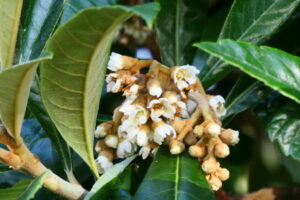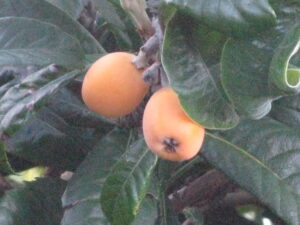Loquat Tree
Rosina T. Schmidt
with the helpful advice of Dr. Richard Beamish
Years back when Dr. Richard Beamish’s friend visited Tasmania on a business trip, he was enchanted with the ornamental, as well as practical loquat tree that he spotted there and brought some seeds home to share with Dick. Lucky for us on Vancouver Island, Dick planted those seeds, grew successfully a tree on his Nanaimo property, and used seeds from his own tree to give to a number of people, this scribe included. Loquat tree grows to about 7.5m (25 feet) tall, with a canopy of evergreen glossy leaves that spreads 5m to 6m (15-20 feet). It is just perfect for a city garden landscape. The large clusters of very attractive coloured fruit stand out beautifully against the dark green tropical foliage.
Apparently the tree from the seed from Tasmania flowers earlier in the season than others, and “it is a little more susceptible to our winter climate variability. If all goes well, the fruit is available about June with a very small second crop in September.” Even though the Loquat blooms in February-March before the bees are out, it does not need to be hand pollinated, as the Humming birds seem to do a god job as well as other critters.
“The fruit is one of the best-tasting fruits,” wrote Dick. Sweet and slightly acidic in flavour, the fruit can be frozen or made into jellies, jams, cobblers, or pies. The tea of leaves is very beneficial, as described on the “Loquat Leaves Tea” page.
Plant the tree in a sunny location, about 8-9m from any structure, electrical lines, and other trees. The tree needs good nutrition and good weed control. The roots are shallow, and a layer of mulch will help keep weeds at bay.
24th of November 2022



 Meetings are held at 7:30pm on the second Thursday of each month from September through May at Beban Park, 2300 Bowen Road, Nanaimo, BC
Meetings are held at 7:30pm on the second Thursday of each month from September through May at Beban Park, 2300 Bowen Road, Nanaimo, BC